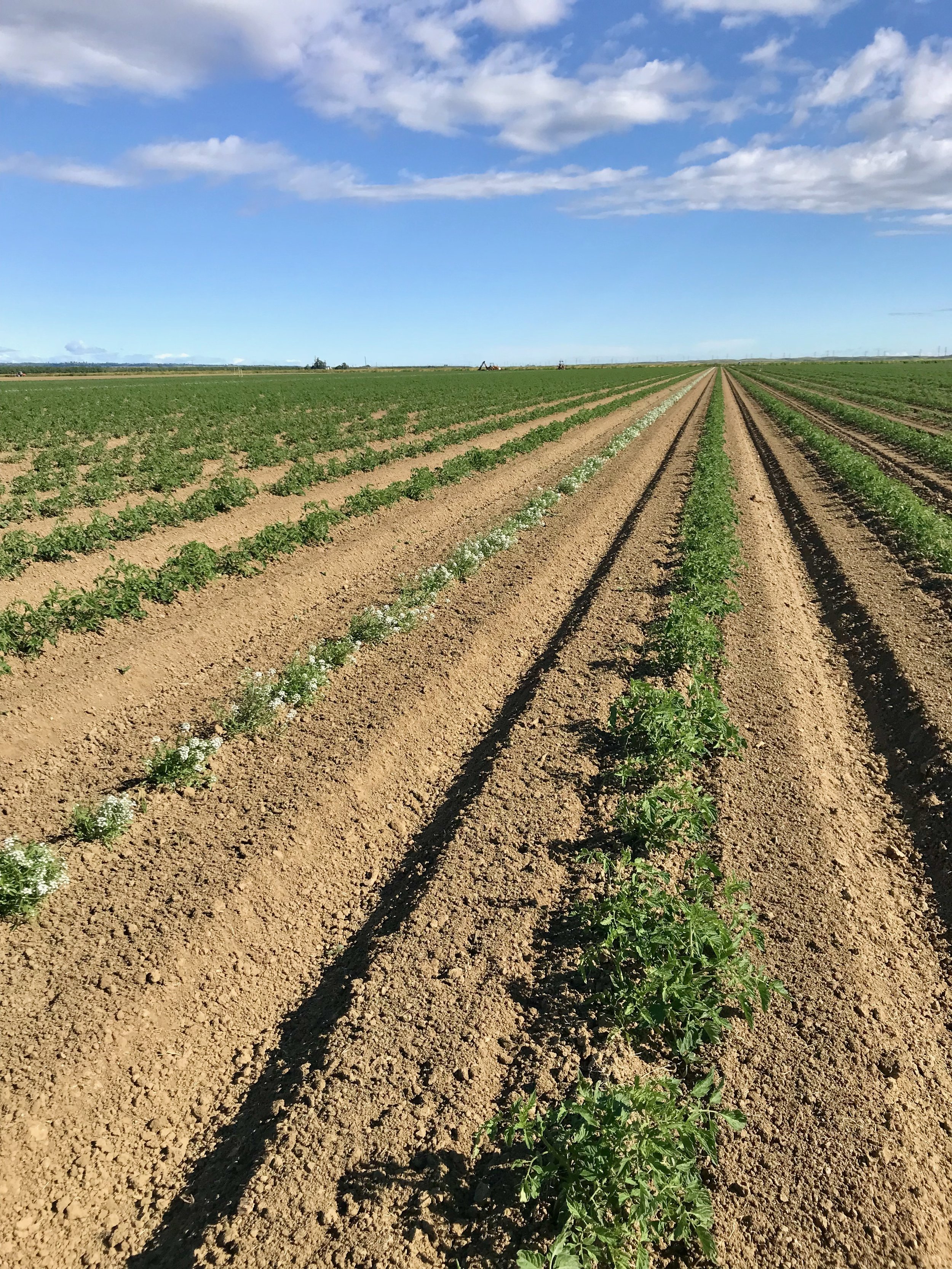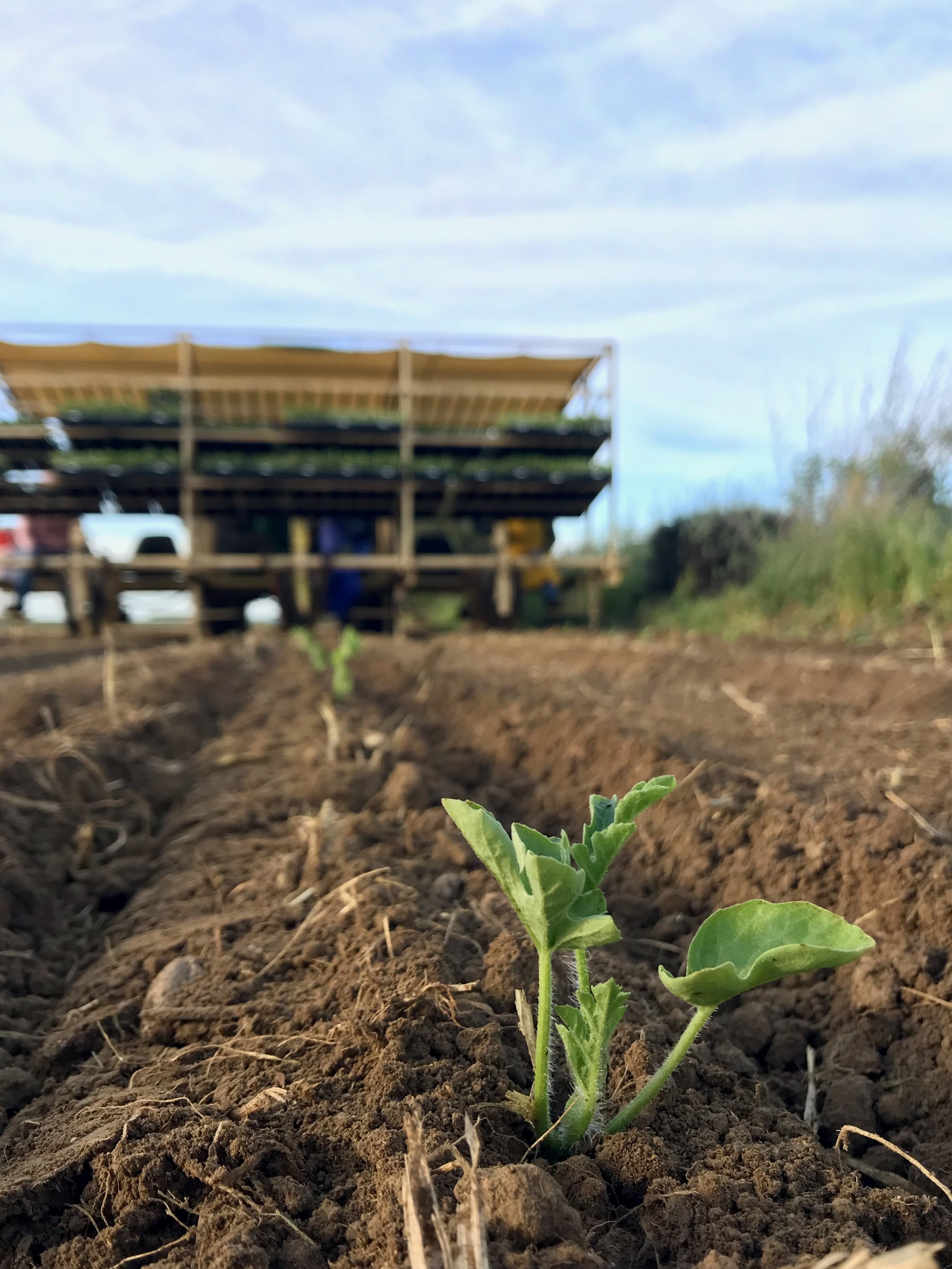Hungry Hollow Happenings: May 2024
The landscape of the farm looks greatly different than it did just a month ago. All the lush green cover crops are out of sight, being digested into the soil. The barley is drying down. Asparagus harvest is bountiful – we’re having trouble keeping up with packing it all – and we’re about half way through our sugar snap pea harvest window. Though, perhaps, the biggest change is all the freshly planted crops!
We’ve got three successions of tomatoes in the ground and are working on our fourth planting of watermelon. We’ve direct seeded (planting seeds directly into the field vs. transplanting young seedlings) our first winter squash and are preparing ground for more. We’re also gearing up to plant more asparagus later this spring.
Planting season is a frenzied season. There is a short window in which we need to “terminate” our cover crops – we talked about that in the last letter – and prepare the field to be planted anew in “cash” crops. Getting all the beds in all the fields prepared at once is tricky (or, rather, impossible). We have a limited number of tractors and tractor drivers, and a seemingly unlimited amount of work to get done in what feels like a very limited amount of time.
Coordinating between the cover crops, soil moisture, and the planting schedules is a bit of a dance. The whole process can get a little complicated, with challenges popping up along the way, but our team makes it look easy with all the parts coming together like a well conducted orchestra.
Once the fields are prepped and the plants arrive, the real frenzy starts. The plants arrive from the greenhouse in big wooden boxes. Inside the boxes are several shelves that hold 14 trays each; each tray has about 300 plants; one planting can have over 60,000 plants to get in the ground. It’s a hurried dash to get the plants out of their trays and into our soils – a dash that can take several days, at times.
The actual planting work is slow and methodical, with much care taken to make sure the plants are safely tucked into their new home in the soil. The tractor moves in “creeper” mode, and our talented transplanting team pulls the plants from the trays and puts them onto the planter wheel, one plant at a time.
Meanwhile, there’s energy buzzing around: forklifts loading and unloading the plant boxes onto trailers to get them in the field; water tanks being emptied and refilled (and then emptied and refilled) to supply the transplanting tractor with water that then makes its way down into the soil with the newly planted plants; and occasionally we have some last-minute final bed prep happening just in front of the transplanter.
All the while we’re trying to keep track of the quantity of plants we received, the acres we plant, all the varieties we have, and just exactly what is going where (or as close to “exactly” as we can get). As soon as we finish planting we start up the irrigation and let it run to make sure the plants have good soil moisture to get going. This inevitably involves checking for (and repairing) leaks in the drip system, as well as digging drainage trenches at the ends of the beds.
And then comes the stress of keeping these young plants safe and healthy! This year, our biggest pests have been darkling beetles (which chew on the stems), cucumber beetles (which feed on the leaves and stems), and what we suspect are seedcorn maggots (which feed on the roots and inside the stems of young plants) – between the three of those pests, they’ve got the entire plant covered.
Unfortunately, there’s not much we can do about the maggots (and possibly other, similar, larvae) feeding on the roots of new plants. This is the type of pest that you have to manage through cultural practices year-round, like the timing of your plantings and the timing of turning in your cover crops – things we can only change so much without interfering with our desired harvest windows. Doubly unfortunate is the fact that damage from the seedcorn maggot is “facilitated by early planting dates, heavy cover crops, and cool-wet weather.” We happened to have all three of those things working against us in our first few plantings, by design. This pest has affected us in the last few years to varying degrees (they were a huge problem in our earlier watermelon plantings two years ago) – the damage this year has been relatively minimal, and hopefully will taper off with our later plantings.
The darkling beetles, on the other hand, can remain a pest throughout the growing season. However, they are especially damaging to young plants and can be devastating if not kept in check. They will “girdle” the stem of the plant, which doesn’t take long on the young, tender, succulent, freshly planted plants. To combat them, we use an insect bait with spinosad as the active ingredient. Spinosad is a natural substance made by a soil bacterium that affects the nervous system of pest insects such as ground beetles, earwigs, and cutworms. Applied in this pelleted form, it poses little to no threat to other invertebrates, wildlife, or the environment. We apply it immediately after planting by dribbling it on the ground right next to the newly planted plants. Unfortunately, it only works if the beetles actually take the bait – which they sometimes don’t when presented with delicious tomato plants as an alternative feast.
Along with the ground beetles, we worry about the damaging cucumber beetles. Cucumber beetles love watermelon plants. If we don’t make efforts to keep them away from our plants, they can skeletonize the leaves and even enter the stems, killing the young plants. To combat the cucumber beetles, we use a mix of diatomaceous earth and kaolin clay. The clay acts as a protectant, forming a shield around the plant and disguising it from insects. Additionally, it protects against sunburn and heat stress damage (which isn’t too much of a problem at this point in the season). In case the beetles do manage to find the plants under the shield of clay, we also apply diatomaceous earth (DE). DE is not poisonous, instead it acts by absorbing the oils and fats under the insects’ exoskeletons, effectively drying them out. DE is made of fossilized remains of diatoms (tiny, aquatic organisms) -- while it can be harmful for humans to breathe in large amounts of the dust of DE (we use protection when applying the material), it is essentially non-toxic to wildlife and our employees.
While we would prefer not to intervene with these hungry bugs, we are, unfortunately, operating within an economy where that is not a risk we can take when confronted with potentially losing our crop. We do follow an Integrated Pest Management system when thinking about how to deal with pests and in designing our farming systems. This means we don’t rely on (organic) pesticides as our only method of control – we plant habitats (both perimeter hedgerows and in-field insectary rows) for beneficial insects and predators, we plant seasonally and climate appropriate crops, and put a big focus on soil and plant health to help the plants with natural defenses against pest and disease. This also hopefully creates an environment where certain pests are kept in check through the ecosystem we foster. However, sometimes we do think it necessary to use (organically approved) materials to treat for pest problems. We scout our fields regularly to monitor for pests so that we can get ahead of problems and minimize our use of these materials. All of this requires a lot of work and careful thought to make sure we are making the best decisions that consider both the success of our crop and the health of our planet.
Anyways, back to the frenzied pace of spring. While we’re moving at fast pace to get our fields prepped and planted, our minds are also running at the same clip trying to keep track of it all and stay ahead of any problems. Things are growing fast, now, and we’ve already staked and are set to begin tying our first planting of tomatoes – hard to believe it’s mid-May!
Amidst all the planting and preparing, our asparagus harvest crew and packing team are working in a similar frenzy. We’re bringing in over 1000 crates of asparagus daily. Once it’s out of the field, it spends the night in our cooler and gets sorted and packed the following day. After we pack, we load the asparagus boxes onto pallets so it can make its way to grocery stores and restaurants where you can enjoy the flavors of the season. You may have noticed our tags got a little refresh this year, but it’s still the same asparagus you know and (hopefully) love. And, we’re soon to be planting more!
The Spring frenzy continues…
Recipes We’re Loving:
Amidst the chaos of May on the farm, we do still need to eat! And, isn’t that why we’re here?
If you haven’t tried this Blistered Asparagus, Goat Cheese, and Date dish, now’s the time! The olive oil blistered savory asparagus with the sweet caramelized dates, meet the tangy soft cheese and crunchy lemony radishes to make a beautiful spring plate topped off with some fresh mint. It really is lovely.
As we near the end of asparagus season it’s time to really dive into those asparagus recipes we’ve been sleeping on! Thankfully, the internet can help with that - here’s a roundup of 31 Asparagus Recipes to help us make the most of this fleeting season. The grilled bacon-wrapped asparagus skewers jumped out at me, as did the asparagus and two-cheese quiche with hashbrown crust…
What are your favorite asparagus recipes? We’d love to know!







